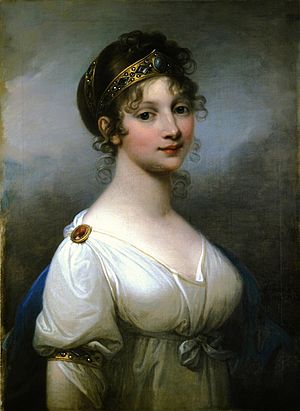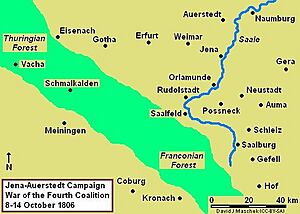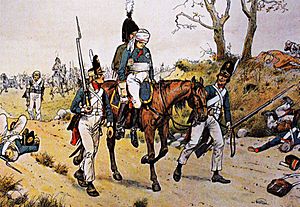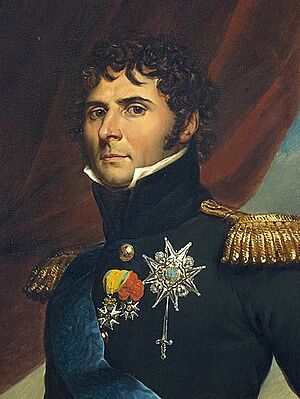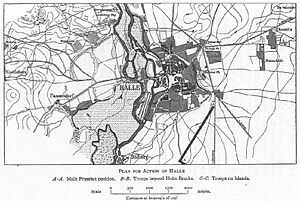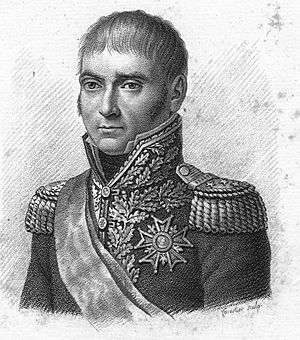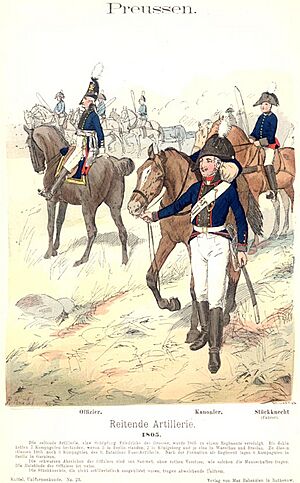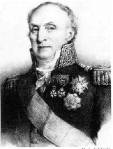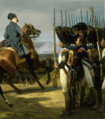Battle of Halle facts for kids
Quick facts for kids Battle of Halle |
|||||||
|---|---|---|---|---|---|---|---|
| Part of the War of the Fourth Coalition | |||||||
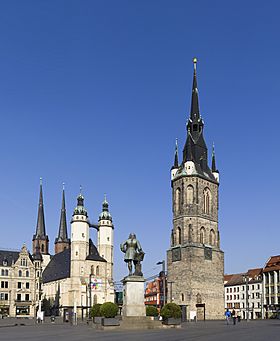 Fighting occurred in the Halle marketplace. |
|||||||
|
|||||||
| Belligerents | |||||||
| Commanders and leaders | |||||||
| Strength | |||||||
| 16,000-20,594 34 guns |
13,700-16,000 58 guns |
||||||
| Casualties and losses | |||||||
| 800 | 5,000-5,200 11 guns 4 colours |
||||||
The Battle of Halle took place on October 17, 1806. It was a fight between a French army led by Jean-Baptiste Bernadotte and the Prussian Reserve army. The Prussian Reserve was commanded by Eugene Frederick Henry, Duke of Württemberg.
The French army won this battle. They forced the Prussians to retreat northeast towards Dessau. The Prussians lost many soldiers. This battle was part of the War of the Fourth Coalition, which was a bigger conflict within the Napoleonic Wars. The city of Halle is in Germany, about 30 kilometers northwest of Leipzig. It sits on the Saale River.
Just before this battle, Emperor Napoleon had invaded Saxony. On October 14, 1806, his armies badly defeated the Prussian and Saxon forces. As the defeated armies ran away, Marshal Bernadotte's French troops marched north. They found Duke Eugene's Prussian Reserve army, which had not yet fought, at Halle.
At the start of the battle, two French divisions quickly attacked the bridges over the Saale River on the west side of Halle. They easily defeated the small group defending the bridges and took control of the city. Later that day, Bernadotte's soldiers charged out of Halle. They attacked Eugene's Reserve, which was lined up southeast of the city. The Prussians were pushed back from their positions and chased northeast.
While this was happening, Bernadotte's third division surrounded a Prussian regiment that was stuck on the west side of the city. They captured it. This battle severely weakened one of the few Prussian forces that was still organized west of the Elbe River.
Contents
Why the Battle Happened
Europe in Conflict
Napoleon's big victory at the Battle of Austerlitz in December 1805 changed a lot in Europe. After that battle, the Austrian Emperor Francis I asked for peace. The Russian Tsar Alexander I pulled his weakened army out of Austria. This ended the War of the Third Coalition.
Prussia was in a tough spot. Its diplomat, Christian Graf von Haugwitz, was about to give Napoleon an ultimatum. But the war ended before he could. Napoleon knew this, which put Prussia at a disadvantage.
In February 1806, Napoleon pressured Prussia. Prussia had to give some of its lands to France and its allies. In return, Prussia got Hanover, which France had taken over. This deal caused Prussia to break ties with Great Britain. The British king was also the ruler of Hanover.
Napoleon kept changing the map of Europe. He created the Confederation of the Rhine in July. He made his brother Joseph Bonaparte king of Naples. His other brother, Louis Bonaparte, became ruler of the Kingdom of Holland. His stepson, Eugène de Beauharnais, became viceroy of the Kingdom of Italy. Then, Napoleon offered Hanover back to Britain for peace. This made Prussia very angry.
Prussia Decides to Fight
The diplomat Haugwitz, who wanted peace, was fired. On August 7, King Frederick William III of Prussia decided to go to war against the First French Empire. His wife, Queen Louise, strongly encouraged him.
Prussia gathered 171,000 soldiers. However, their army had not kept up with the new ways of fighting that had developed over the last ten years.
The War Begins
The Prussian army moved into Saxony. About 20,000 Saxon soldiers joined them. These combined forces formed three main armies. They were led by Charles William Ferdinand, Duke of Brunswick, Frederick Louis, Prince of Hohenlohe-Ingelfingen, and Ernst von Rüchel.
Brunswick's main army was in the middle at Erfurt. Hohenlohe's army was in the east near Rudolstadt. Rüchel's army was in the west at Gotha and Eisenach. Duke Eugene of Württemberg's Reserve army was far north at Magdeburg.
On October 8, Napoleon sent 180,000 French troops across the Saxon border. His army moved in a large square formation. On October 9, French cavalry and a division led by Marshal Bernadotte pushed back a Prussian division at the Battle of Schleiz. The next day, Marshal Lannes's troops attacked Prince Louis Ferdinand of Prussia's division at the Battle of Saalfeld. The young prince was killed, and his division was badly beaten.
Napoleon thought the main Prussian armies were near Erfurt. So, on October 12, he ordered his army to turn left. The Prussian generals decided to fall back. Brunswick was to take the main army north from Weimar to Merseburg. Hohenlohe would protect this move by defending near Jena.
On October 14, two major battles happened at the same time: the Battle of Jena-Auerstedt. Napoleon attacked Hohenlohe's army at Jena. Meanwhile, Brunswick's main army ran straight into Marshal Davout's French corps at Auerstedt. Both Prussian armies, along with Rüchel's corps, were completely defeated and scattered. Brunswick's army lost 13,000 soldiers, and he was badly wounded. Hohenlohe and Rüchel's forces together lost as many as 25,000 soldiers.
The Battle of Halle
French and Prussian Forces
At the start of the campaign, Marshal Bernadotte's French I Corps had about 19,000 infantry, 1,500 cavalry, and 34 cannons. His corps was made up of three divisions.
Duke Eugene of Württemberg's Prussian Reserve army included two infantry divisions, an advance guard, and a cavalry reserve. It had about 18 battalions, 20 cavalry squadrons, and 32 cannons, not counting smaller regimental cannons.
The Fight for Halle
After the Jena-Auerstedt battles, Bernadotte's troops were near Apolda. On the morning of October 15, Napoleon ordered Bernadotte to march towards Halle. By October 16, Bernadotte's leading troops were close to Halle. He learned that the Prussian Reserve was there and planned to attack.
Duke Eugene's Reserve army had about 16,000 soldiers. On October 10, he was ordered to go to Halle. By October 13, his army was in Halle. He had smaller groups of soldiers in nearby towns like Merseburg and Leipzig.
On October 14, Eugene heard the sounds of the Jena-Auerstedt battles. He didn't get news of the disaster until the evening of October 15. On October 16, he still had no new orders. He called back his smaller groups of soldiers to Halle. He also sent a group to hold Dessau on the Elbe River.
Eugene placed his main force on high ground south of Halle. His battle line faced northwest towards the city. He left some soldiers to defend the bridges on the east side of Halle.
Before dawn on October 17, Bernadotte's army marched from Querfurt towards Halle. He soon learned that a Prussian column was coming from Eisleben. He left one division to watch this column and rushed to Halle with his other two divisions.
On the west side of Halle, the Saale River splits into three parts. The main road crossed these parts using a series of covered bridges. From Halle, roads led north to Magdeburg, northeast to Dessau, southeast to Leipzig, and south to Merseburg.
On October 17, Eugene had about 11,350 infantry, 1,675 cavalry, and 58 cannons in Halle. Bernadotte's attacking force had about 12,190 infantry, 1,000 cavalry, and 12 cannons.
Around 8:00 AM, Bernadotte's leading troops pushed back a Prussian cavalry regiment on the west bank. Eugene sent some infantry and cannons to help. He also started sending his supply wagons back towards Dessau. But the wagon drivers panicked and fled, leaving many wagons behind.
Bernadotte decided to attack at 10:00 AM. He sent Dupont's division to charge the bridges. The French soldiers rushed along the road, fighting through the defenders. They quickly captured all three bridges and the first island. Prussian soldiers on the sides of the road were cut off and captured. Those who couldn't retreat in time had to swim the river.
In less than an hour, Dupont's troops took the bridges and entered the town. They quickly defeated a Prussian battalion in the marketplace and chased another out of the city gate. Halle was quickly taken. The French then waited for the rest of Bernadotte's army to arrive.
Eugene, positioned southeast of Halle, was in a bad spot. His escape route to the north passed right by the east side of Halle. He quickly moved two battalions north to block the French from cutting off his retreat. The French set up defenses at the city gates and along the edge of Halle. As more French troops arrived, they joined the fight. French skirmishers moved forward, firing at the Prussians.
Finally, the French charged out of Halle and attacked the Prussian line. The Prussians fired many cannons, but the French quickly gained the upper hand at the city gates. The Prussian cavalry was outflanked and fell back. Eugene's army split in two. His right side retreated towards Dessau, and his left side towards Bitterfeld.
The right side retreated in good order. They paused at Mötzlich and Oppin, where a cavalry charge stopped the French from chasing them further. The left side had worse luck. They were chased by French divisions and cavalry. The Prussian cavalry managed to push back the French cavalry once, but then they were driven off by newly arrived French infantry. The French chased the Prussians all the way to Bitterfeld, where the Prussians burned the bridge over the Mulde River to stop them.
Meanwhile, General-Major Treskow and his regiment, coming from Eisleben, found the main road blocked. He tried to reach Halle by going north of a nearby forest. As he got close to the Halle bridges, his advance was stopped by French soldiers. When Drouet arrived, he attacked the Prussians.
Treskow's troops were stopped from escaping through the forest. They retreated north along the west bank of the river in two squares. Near Kröllwitz, the Prussians became confused in a marshy area and lost all their cannons. Soon after, Drouet attacked the Treskow Regiment and forced them to surrender. The Prussians lost 200 soldiers killed or wounded in this final part of the battle.
What Happened After
The Prussians reported that 13 officers were killed, 26 wounded, and 74 captured. In total, about 5,000 Prussian soldiers were killed, wounded, or captured. The French captured four flags from the Treskow Regiment and 11 cannons, plus many smaller regimental cannons. Bernadotte reported about 800 French soldiers killed or wounded.
Historians say that Eugene of Württemberg waited too long in Halle. His defense was not strong enough, and his position south of Halle was poorly chosen because his escape route was exposed. He should have burned the bridges and held the east bank of the river. Even better, he should have retreated to Magdeburg. There, his army could have helped the shattered main Prussian armies. Instead, his Reserve army was badly damaged by the battle.
On October 18, Bernadotte's troops rested. They were tired from a long march and a big battle. Eugene's remaining soldiers crossed the Elbe River at Rosslau and reached Magdeburg on October 19.
Images for kids


